What did you personally accomplish this week on the project? Give files or photos that demonstrate your progress. Prove to the reader that you put sufficient effort into the project over the course of the week (12+ hours).
Progress from Last Week
My teammates and I successfully finished ordering all of the essential parts for our project and have created our design presentation slides.
The more pressing tasks I had to complete over this past week included deciding between which idea to implement for tracking our game data and beginning to implement that method. Upon consulting with my team and Omkar we decided on implementing the method where we will be listening for each game event and casing on the actions that we wish to track (i.e. attack, forceful jump, getting hit and low health).
Some game actions have been harder to track than others. For instance, it is hard to track low health as it would require listening in on all of the enemies’ game data, whereas it is much easier to listen for the user’s game attack actions.
After gaining a better understanding of how we expect the game code to interface with the Node JS server, I realized that we should transfer all of the game code from Javascript to Node JS. I have accordingly revised Figure 1. below to accurately portray this relationship.
Figure 1. Shows how the game software will use socket.io to relay information to the Node JS server. The server will then use the serial port package to send this information to our Arduino.

Is your progress on schedule or behind? If you are behind, what actions will be taken to catch up to the project schedule?
Having discovered that I might have to translate all the game code from HTML, CSS and JavaScript to Node JS, I will be dedicating the beginning of this week to accomplishing this. After successfully achieving this, I will move on to listening to the game events of different sized enemies within The Last Spartan. My schedule for this week is thankfully flexible enough to accommodate these unforeseen changes.
What deliverables do you hope to complete in the next week?
I plan to finish transferring the game code from Javascript, HTML and CSS to Node JS as well as start tracking the coordinates and game actions of the different enemies within the game.
Please list the particular ECE courses (if any) that covered the engineering science and mathematics principles your team used to develop your design? If there are no courses please tells us how you learned those principles over the last week?
I primarily utilized principles from 18213 Introduction to Computer Systems in understanding the design of our Node JS server. I particularly referred to the knowledge I gained from implementing Proxy Lab, which utilized sockets. I similarly plan to use sockets in sending data from our desktop game to the Arduino. By understanding how to implement these sockets and use the http library I have been able to create event listeners that are compatible with the Node JS server.






